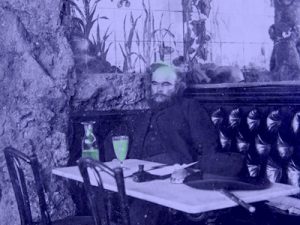Paul-Marie Verlaine was born March 30, 1844 in the town of Metz on the Eastern border of France. His father, a French army officer, brought the family to Paris when Paul-Marie was seven years old.
As a young man, Verlaine made several attempts at a normal life, studying law for a couple of years, working as an insurance clerk. He married a young woman named Mathilde in 1870, and they had a son, Georges. He socialized in “bohemian” crowds as well as at more upper-class salons. He became fascinated with the poetry of Baudelaire, and worked with a publisher to arrange the publication of his own first volume, “Poemes Saturniens,” in 1866.
Verlaine’s sardonic, wistful early work had much in common with the impressionist art that was being invented elsewhere in Paris at the same time. His poems were neat, sparse miniatures of life’s moments: first kisses, seashells, mimes on the street.
But Verlaine was uniquely open to the influences of his surroundings, and would soon evolve his style, and his life, through several phases. When Paris fell into revolutionary havoc in 1870, Paul Verlaine cast his lot with the Commune, and worked as a censor with the radical improvised government that held the city for only a brief time.
His next phase was completely apolitical. He received a letter from an unknown teenage poet named Rimbaud in 1871. Verlaine recognized Rimbaud’s poetic talent and despite the fact that he was apparently heterosexual (or at least had been up to this time) fell madly in love with him. The two poets travelled together for a short time, and Verlaine helped Rimbaud become a literary celebrity in Paris. But when it became clear that Rimbaud was going to move on and leave Verlaine behind, the older poet could not stand the loss. A series of bitter fights ensued, and Verlaine ended up firing a gun at Rimbaud, injuring his wrist. Rimbaud pressed charges, sending Verlaine to prison for two years, before fleeing the world of literary fame in disgust.
After two years in jail Verlaine went through a Catholic phase, experimented with farming, and in 1881 published a book of mature, spiritually conservative book of poetry, “Sagesse” (“Wisdom”), that sold better than any of his previous books and greatly increased his literary reputation.
But he would return to darker themes. He spent his later years drinking absinthe in Paris cafes and behaving bizarrely in front of admiring crowds. In 1894, two years before his death, he published a volume entitled “The Posthumous Book”. His poetry became increasingly self-referential, and the cliched image of the absinthe-soaked celebrity poet became the central theme of his work. He died on January 8, 1896 at the home of a prostitute.
To read Verlaine’s poetry from any of his life phases is a pleasing and enjoyable revelation. His life story seems fierce and self-indulgent, but his verses always betray a humble, affectionate touch and a humane sense of life. I once chose a book of original Verlaine poems printed alongside their English translations to teach myself French; his vocabulary is simple and the meanings are always clear.
Bob Dylan memorialized Verlaine, humorously, by alluding to his famously ruinous love affair on the album “Blood on the Tracks”:
“Situations have ended sad
relationships have all been bad
mine have been like Verlaine’s and Rimbaud’s”.
In the mid 1970’s a punk musician named Tom Miller, soon to be in a punk band called Television, also memorialized Paul Verlaine by changing his name to Tom Verlaine.



